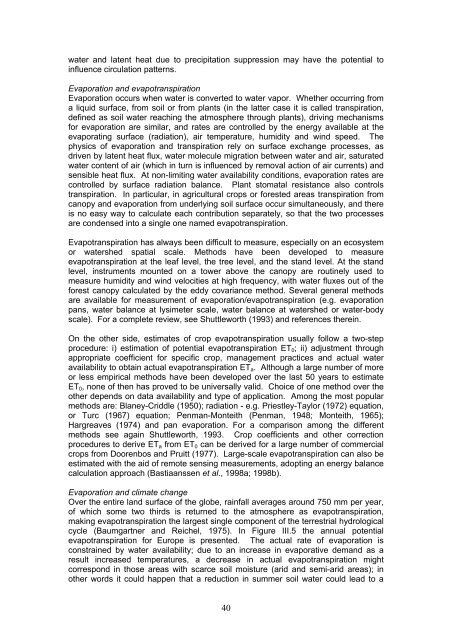Climate Change and the European Water Dimension - Agri ...
Climate Change and the European Water Dimension - Agri ...
Climate Change and the European Water Dimension - Agri ...
Create successful ePaper yourself
Turn your PDF publications into a flip-book with our unique Google optimized e-Paper software.
water <strong>and</strong> latent heat due to precipitation suppression may have <strong>the</strong> potential to<br />
influence circulation patterns.<br />
Evaporation <strong>and</strong> evapotranspiration<br />
Evaporation occurs when water is converted to water vapor. Whe<strong>the</strong>r occurring from<br />
a liquid surface, from soil or from plants (in <strong>the</strong> latter case it is called transpiration,<br />
defined as soil water reaching <strong>the</strong> atmosphere through plants), driving mechanisms<br />
for evaporation are similar, <strong>and</strong> rates are controlled by <strong>the</strong> energy available at <strong>the</strong><br />
evaporating surface (radiation), air temperature, humidity <strong>and</strong> wind speed. The<br />
physics of evaporation <strong>and</strong> transpiration rely on surface exchange processes, as<br />
driven by latent heat flux, water molecule migration between water <strong>and</strong> air, saturated<br />
water content of air (which in turn is influenced by removal action of air currents) <strong>and</strong><br />
sensible heat flux. At non-limiting water availability conditions, evaporation rates are<br />
controlled by surface radiation balance. Plant stomatal resistance also controls<br />
transpiration. In particular, in agricultural crops or forested areas transpiration from<br />
canopy <strong>and</strong> evaporation from underlying soil surface occur simultaneously, <strong>and</strong> <strong>the</strong>re<br />
is no easy way to calculate each contribution separately, so that <strong>the</strong> two processes<br />
are condensed into a single one named evapotranspiration.<br />
Evapotranspiration has always been difficult to measure, especially on an ecosystem<br />
or watershed spatial scale. Methods have been developed to measure<br />
evapotranspiration at <strong>the</strong> leaf level, <strong>the</strong> tree level, <strong>and</strong> <strong>the</strong> st<strong>and</strong> level. At <strong>the</strong> st<strong>and</strong><br />
level, instruments mounted on a tower above <strong>the</strong> canopy are routinely used to<br />
measure humidity <strong>and</strong> wind velocities at high frequency, with water fluxes out of <strong>the</strong><br />
forest canopy calculated by <strong>the</strong> eddy covariance method. Several general methods<br />
are available for measurement of evaporation/evapotranspiration (e.g. evaporation<br />
pans, water balance at lysimeter scale, water balance at watershed or water-body<br />
scale). For a complete review, see Shuttleworth (1993) <strong>and</strong> references <strong>the</strong>rein.<br />
On <strong>the</strong> o<strong>the</strong>r side, estimates of crop evapotranspiration usually follow a two-step<br />
procedure: i) estimation of potential evapotranspiration ET0; ii) adjustment through<br />
appropriate coefficient for specific crop, management practices <strong>and</strong> actual water<br />
availability to obtain actual evapotranspiration ETa. Although a large number of more<br />
or less empirical methods have been developed over <strong>the</strong> last 50 years to estimate<br />
ET0, none of <strong>the</strong>n has proved to be universally valid. Choice of one method over <strong>the</strong><br />
o<strong>the</strong>r depends on data availability <strong>and</strong> type of application. Among <strong>the</strong> most popular<br />
methods are: Blaney-Criddle (1950); radiation - e.g. Priestley-Taylor (1972) equation,<br />
or Turc (1967) equation; Penman-Monteith (Penman, 1948; Monteith, 1965);<br />
Hargreaves (1974) <strong>and</strong> pan evaporation. For a comparison among <strong>the</strong> different<br />
methods see again Shuttleworth, 1993. Crop coefficients <strong>and</strong> o<strong>the</strong>r correction<br />
procedures to derive ETa from ET0 can be derived for a large number of commercial<br />
crops from Doorenbos <strong>and</strong> Pruitt (1977). Large-scale evapotranspiration can also be<br />
estimated with <strong>the</strong> aid of remote sensing measurements, adopting an energy balance<br />
calculation approach (Bastiaanssen et al., 1998a; 1998b).<br />
Evaporation <strong>and</strong> climate change<br />
Over <strong>the</strong> entire l<strong>and</strong> surface of <strong>the</strong> globe, rainfall averages around 750 mm per year,<br />
of which some two thirds is returned to <strong>the</strong> atmosphere as evapotranspiration,<br />
making evapotranspiration <strong>the</strong> largest single component of <strong>the</strong> terrestrial hydrological<br />
cycle (Baumgartner <strong>and</strong> Reichel, 1975). In Figure III.5 <strong>the</strong> annual potential<br />
evapotranspiration for Europe is presented. The actual rate of evaporation is<br />
constrained by water availability; due to an increase in evaporative dem<strong>and</strong> as a<br />
result increased temperatures, a decrease in actual evapotranspiration might<br />
correspond in those areas with scarce soil moisture (arid <strong>and</strong> semi-arid areas); in<br />
o<strong>the</strong>r words it could happen that a reduction in summer soil water could lead to a<br />
40













